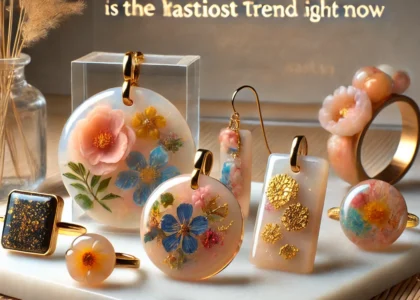Introduction to Resin Jewelry
Resin jewelry has gained popularity due to its beauty, versatility, and affordability. Crafted from synthetic or natural resin, these accessories are lightweight, durable, and customizable. Whether you’re an artisan, a jewelry enthusiast, or someone looking to start a creative hobby, resin jewelry offers endless possibilities.
What is Resin Jewelry?
Resin jewelry is made using liquid resin, which hardens into a solid, glass-like finish. Crafters embed flowers, glitter, beads, and other decorative elements to create unique designs. The result is stunning, handcrafted jewelry that appeals to various tastes. The versatility of resin allows artists to experiment with different colors, textures, and inclusions.

Types of Resin Used in Jewelry Making
1. Epoxy Resin
- Most common resin used for jewelry
- Provides a glossy, clear finish
- Easy to work with and beginner-friendly
- Takes several hours to cure
2. UV Resin
- Cures quickly under ultraviolet light
- Ideal for small projects and intricate designs
- Requires specialized UV light equipment
- Limited working time before curing begins
3. Polyester Resin
- Highly durable and scratch-resistant
- Strong odor, requiring proper ventilation
- Fast curing time
- Requires expertise to handle effectively
4. Polyurethane Resin
- Quick curing and highly durable
- Can be more difficult to work with
- Offers a variety of textures and finishes
How is Resin Jewelry Made?
1. Preparing the Mold
- Silicone molds are used to shape the resin into various jewelry forms
- Available in different sizes and designs, from rings to pendants
2. Mixing the Resin
- Resin and hardener are combined in a precise ratio
- Proper mixing prevents bubbles and ensures a smooth finish
3. Adding Decorative Elements
- Dried flowers, metallic flakes, glitters, and pigments can be added
- These elements enhance the uniqueness of each piece
4. Pouring the Resin
- The resin mixture is poured into molds carefully to avoid bubbles
- Some artisans use a heat gun or torch to remove air bubbles
5. Curing the Resin
- Epoxy resin requires 12-24 hours to fully cure
- UV resin hardens in minutes under UV light
6. Finishing Touches
- Once cured, the piece is removed from the mold
- Sanding and polishing improve the texture and shine
- A final protective coating may be applied for extra durability
Why is Resin Jewelry Popular?
- Customizable – Each piece is unique, making it ideal for personal expression.
- Affordable – Less expensive than metals and gemstones, making it accessible to all.
- Lightweight – Comfortable for everyday wear.
- Durable – Resistant to cracking and breaking when properly cured.
- Eco-Friendly Options – Some artisans use plant-based or biodegradable resins.
How to Care for Resin Jewelry
- Keep Away from Heat: Excessive heat can soften or warp resin jewelry.
- Avoid Chemicals: Perfumes, lotions, and cleaning agents can damage the finish.
- Store Properly: Keep pieces in a soft pouch or jewelry box to prevent scratches.
- Clean Gently: Use a soft cloth to wipe the surface and maintain shine.
Is Resin Jewelry Safe to Wear?
Yes, properly cured resin jewelry is safe. However, direct skin contact with uncured resin should be avoided, as it may cause irritation. Always ensure that the resin is fully hardened before wearing.
DIY Resin Jewelry: Can You Make It at Home?
Yes! With the right materials and techniques, anyone can create stunning resin jewelry. Beginners should start with epoxy resin kits, which include molds, pigments, and mixing tools. Follow these steps for DIY resin jewelry:
- Gather Supplies: Resin, hardener, silicone molds, pigments, decorations, mixing cups, gloves.
- Prepare the Workspace: Work in a well-ventilated area and cover surfaces to prevent spills.
- Mix the Resin Properly: Follow instructions for the correct resin-to-hardener ratio.
- Add Pigments & Decorations: Customize with colors and embellishments.
- Pour & Cure: Slowly pour the resin and allow proper curing time.
- Polish & Finish: Once hardened, sand rough edges and apply a finishing coat.
Where to Buy Resin Jewelry?
For high-quality, handcrafted resin jewelry, explore Rewons by Namrata. Our exclusive collection features unique, artistic designs that add elegance to any outfit. We offer:
- Custom Resin Jewelry – Get personalized pieces tailored to your style.
- Exclusive Handmade Designs – Every piece is crafted with love and precision.
- Premium Quality Materials – We use high-grade resin for durability and shine.
Pros and Cons of Resin Jewelry
Pros:
- Unique and customizable
- Affordable compared to fine jewelry
- Lightweight and comfortable
- Versatile design options
Cons:
- Can be sensitive to heat and chemicals
- May yellow over time if exposed to UV light
- Requires careful handling to avoid scratches
Conclusion
Resin jewelry is an exciting blend of art and craftsmanship. Whether you’re looking to buy a beautiful piece or create your own, resin jewelry offers endless possibilities. With proper care, these accessories can last for years, making them a great addition to any collection.
For exclusive, handcrafted resin jewelry, visit Rewons by Namrata today and explore our beautiful range of designs! for creating your own website click here.


